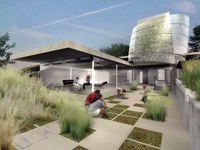 This news bit is a little late, but still worth noting: Last month, an independent team made up of designers from Seattle architecture/design firm Mithun won first place in an international sustainable housing competition in Roanoke, Virginia, with their design for a house powered by–of all things–spinach. The house (the design is pictured at left) will be built this summer in Roanoke, along with other contest winners.
This news bit is a little late, but still worth noting: Last month, an independent team made up of designers from Seattle architecture/design firm Mithun won first place in an international sustainable housing competition in Roanoke, Virginia, with their design for a house powered by–of all things–spinach. The house (the design is pictured at left) will be built this summer in Roanoke, along with other contest winners.
The C2C Home Competition, which drew 625 entries from 41 countries, was inspired by William McDonough and Michael Braungart’s work on cradle-to-cradle design principles. They ask designers to go beyond pollution prevention to creating objects and processes that nourish and replenish our communities, using materials that can be recycled indefinitely.
The team’s house takes energy from the sun and uses spinach protein sandwiched between glass to generate electricity for the entire neighborhood, turning the house into a supplier rather than a consumer–a house that acts more like a tree than like a machine.
The architects–a seven-member team led by Tim Meldrum and Matthew Coates–were influenced by early U.S. homes, where the energy source–the fireplace–was central to the occupants’ daily lives. Chopping and hauling logs to feed the fireplace resulted in daily, vivid awareness of what and how much was consumed to heat the home.
While modern houses tend to relegate their heaters and furnaces to the basement, the Mithun team decided to return the house’s energy source to its central, visible place in the home. As described in the February 18 issue of the Portland Daily Journal of Commerce (subscription only), the team’s house has a two-story, chimney-like core that rises from the central cooking area and towers over the building (pictures available at the contest site and at Worldchanging). The core includes solar collection materials, a skylight, a heat sink, a ventilation stack, and mechanisms for rainwater collection and blackwater and graywater treatment.
While the ventilation stack and rainwater management systems are extensions of oft-used green building technologies, the heat sink, skylight and energy collection materials work in tandem to harness and then redirect solar energy like no home before, its designers said.
The skylight brings in the sun’s rays, and the heat sink stabilizes temperatures, while a highly conductive material produces photosynthetic energy generated from the protein in spinach. The spinach proteins are sandwiched between the core’s glass walls; their chlorophyll converts the sun’s rays to fuel the home.
This might seem a little pie-in-the-sky, but in fact, the contest is focused on affordability and practicality: contest organizers plan to build a whole neighborhood of solar-powered, sustainable, and affordable homes in Roanoke, starting with the contest’s winning designs. Mithun’s house will be built using current technologies, and retrofitted as new ones become available.
Eventually, they hope to turn Roanoke into a showcase for affordable, eco-friendly design that directly challenges the current trend of sprawling subdivisions full of mini-mansions.
Finally, Metropolis.mag describes how the contest is spurring the next generation of architects to start grappling with the challenges of designing sustainable housing.
p.s. Watch for next month’s Sustainable Industries Journal, whose feature story will be an inside look at the Mithun team’s design.


